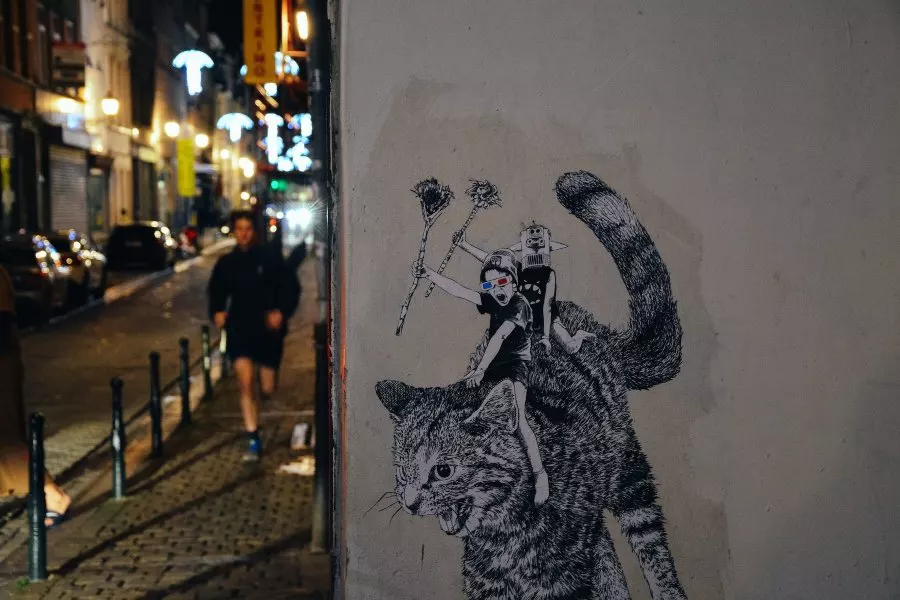
Visit an art gallery, and most probably, you’ll find at least one painting with a cat depicted in it. Cats have been included in many paintings over centuries, and cat art forms part of many art collections.
Cats in paintings might have symbolic value and be included in a painting to convey specific messages. The symbolic value varies from art period to art period and often even from painter to painter in the same period.
In this article, we’ll briefly look at famous cat paintings through the ages, including the importance of old cat paintings and cats in the Renaissance period. Then we’ll discuss cats in art during the 19th Century – mainly by briefly looking at a few favorite famous cat paintings created in the 1800s.
Cats in Ancient Egyptian Religious Art
Domestic cats, as we know them today, have been with us for thousands of years. They also made their appearances in artwork for just as long. In ancient times, cats were also sometimes seen as gods or goddesses. The Egyptians, for instance, worshiped Bastet, the cat goddess.
The Egyptians erected a temple for Bastet and filled it with more than 600 cat statues. They worshiped the cat goddess with the statues and honored her domesticity and fertility. Cats were also associated with other Egyptian gods. Cats, for instance, also represented the Sun-god Ra.
Renaissance Paintings Of Cats
If we now make a leap from ancient times to the 15th and 16th centuries AD, we find that during the Renaissance art period, it was the custom to use cats in paintings to convey specific messages. Most art historians agree that although cats have been used to carry symbolic value and messages in all art periods, the Renaissance period was when artists used cat-related symbolism the most.
The famous “Adam and Eve” by Albrecht Dürer (1471-1528) is a good example of cats in Renaissance art.
Cats In Other Art Periods
Before we specifically discuss a few 19th-century cat artworks, let’s briefly look at cats in art during other art periods than the Renaissance. For Picasso, for instance, cats symbolized feral femininity. So he usually painted them where they were slashing into birds and lobsters.
Some Victorian painters “softened” their portraits of children by including cats as an expression of innocence.
If we leap again right into the 2000s, you’ll find the cat artworks of the Japanese artist Haruki Kudo. It is difficult to believe that his realistic images of cats are not photographs. His hand-drawn pencil drawings are so good that you only realize they are paintings and not photographs if you have a closer look at the artwork. This type of painting is called “hyperrealism”, requiring incredible skill.
Cats In Art In The 19th Century: “The Awakening Conscience” By Holman Hunt (1853)
The best way to learn about cats in 19th-century art is to look at specific cat artworks and find out what the artists had in mind with the cat or cats in the paintings. For instance, the Holman Hunt painting “The Awakening Conscience” invites you to give your own meaning of why a cat is included in the painting. These “guessing games” regarding the interpretation of cats in paintings were very popular in the 1800s.
This painting depicts a woman sitting on a man’s lap at a piano and a cat in the corner of the room. The cat is with a bird caught, but you don’t indicate whether the bird will fly away or be eaten.
Some art scholars believe that this cat-bird dilemma also symbolizes that you don’t know whether the woman “has been caught” by the man or is “escaping” from him.
Cats In Art In The 19th Century: “The Flood” By John Everett Millais (1870)
Another trend in the 1800s was to use a cat as the symbol of what the viewer is most probably experiencing when looking at the artwork. John Everett Millais’ artwork “The Flood.”
He depicted a black cat in a cradle with a baby who had been swept away during the Great Sheffield flood that had killed 250 people. The painting shows a baby lying in a cradle as it’s swept away. The cat is in terror at the baby’s feet, and its yowls symbolize the viewer’s fear of the fate awaiting the baby.
Famous Cat Art In The 19th Century With No Symbolic Value Attached To The Cat
Although cats were frequently used for their symbolic value in 19th-century paintings, many paintings were created with cats as the subject, or part of the subject, without any specific symbolic value attached to it.
“The Bachelor Party” (1896) by Louis Wain is an artwork. Most art lovers and historians consider it as one of the most famous cat paintings. It depicts a comical scene of a group of cats sitting around a table, enjoying a few drinks and smoking cigars. This painting was created without any hidden message and was painted just to be enjoyed!
Another very famous 19th-century cat painting without any hidden messages is “Julie Manet (Child with Cat)” by Pierre-Auguste Renoir. It was painted in 1887 and is simply a portrait of a little girl holding her cat.
Conclusion
For centuries, cats have been part of art and paintings. They were often used as specific symbols to emphasize certain aspects or messages the artist wanted to convey. In paintings created during the 19th Century, you’ll still find instances where cats are included for their symbolic value. But there are also many cat paintings from that Century that were painted without hidden messages. Instead, cats were just painted as the subject or part of the subject of the painting – often depicting the cat simply as a person’s favorite pet.








